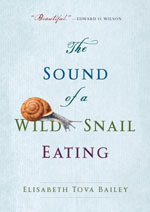Elisabeth Tova Bailey: The Sound of a Wild Snail Eating
In her first book, the memoir The Sound of a Wild Snail Eating, Elisabeth Tova Bailey invites us to the intimate world inhabited only by a small snail and herself. Confined for a year to a bed in a sterile and unfamiliar room due to a mysterious and debilitating neurological illness, Bailey closely observed a woodland snail brought to her bedside by a friend in a pot of violets. Without even the strength to sit up or read, she found solace in the snail’s company: by day, bedridden while the world outside carried on without her, and at night, lying awake while everyone else slept, Bailey “observed [the snail] without thinking… simply to feel connected to another creature; another life was being lived just a few inches away.”
At its best, Bailey’s writing is eloquent and poetically insightful. It is no doubt rooted in years of intense introspections; although the book covers the span of a year, Bailey has lived with the illness for close to two decades. When even rolling over from one side to another in bed caused her heart to “beat wildly and erratically,” Bailey observed that “the random way [her] friends moved around the room… was as if they didn’t know what to do with their energy. They were so careless with it.” She later observes that “It was all I could do to get through each moment, and each moment felt like an endless hour, yet days slipped silently past.”
While Bailey unflinchingly portrays her devastating physical and mental state, this delightful book at no point feels tragic or sentimental. At times unapologetically enthusiastic, Bailey captivates us with her utter fascination with the creature that has “kept [her] spirit from evaporating.” She draws copiously from over four hundred years of natural history, science, and literature. Each chapter opens with an epigraph quoting a poet, a naturalist, or a contemporary scientist, among others. Interwoven in the text with the introspection on Bailey’s personal illness and the detailed first-hand observation of her snail are her findings on the wondrous life and biology of mollusks and gastropods. In this small book, Bailey surprisingly manages to cover an extraordinary range of topics, from their physiology to evolutionary history, to their psychology and their sensual and fascinating mating habit.
Bailey’s passion is infectious; it is hard not to get fascinated when you learn that, with only three senses—smell, taste, and touch—at its disposal, a snail lives in a world of silence. Or that its 2,640 teeth are completely replaced over the course of four to six weeks. Or how the logarithmic spiral of its shell is formed and repaired, and how they survive harsh weathers—both hot and cold—by sealing themselves up for years.
It took a mysterious pathogen to bring Bailey “nose-to-tentacle” with this small yet infinitely wondrous world of gastropods. In this beautiful book, adorned with delicate illustrations by Susan Brand and Kathy Bray, she now invites us to be intrigued. And when we are, as we most likely will be, the book even comes with a little tip for creating our own terrarium.
 Elisabeth Tova Bailey
Elisabeth Tova Bailey